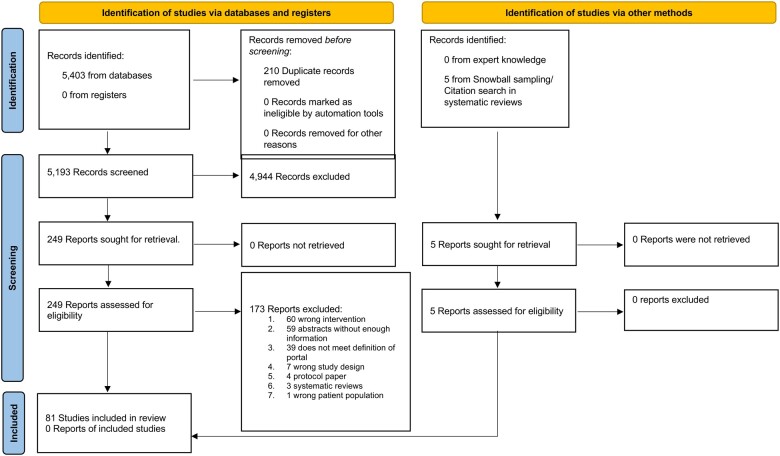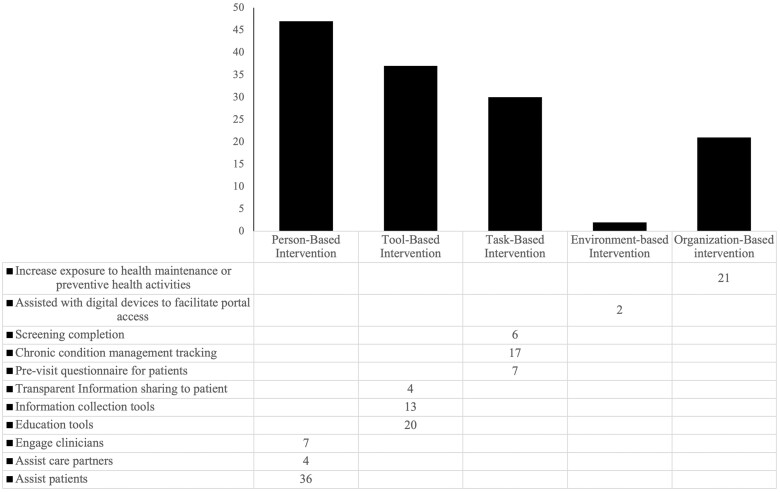Patient portal interventions: a scoping review of functionality, automation used, and therapeutic elements of patient portal interventions.
IF 2.5
Q2 HEALTH CARE SCIENCES & SERVICES
引用次数: 1
Abstract
Abstract Objectives We sought to understand the objectives, targeted populations, therapeutic elements, and delivery characteristics of patient portal interventions. Materials and Methods Following Arksey and O-Malley’s methodological framework, we conducted a scoping review of manuscripts published through June 2022 by hand and systematically searching PubMed, PSYCHInfo, Embase, and Web of Science. The search yielded 5403 manuscripts; 248 were selected for full-text review; 81 met the eligibility criteria for examining outcomes of a patient portal intervention. Results The 81 articles described: trials involving comparison groups (n = 37; 45.7%), quality improvement initiatives (n = 15; 18.5%), pilot studies (n = 7; 8.6%), and single-arm studies (n = 22; 27.2%). Studies were conducted in primary care (n = 33, 40.7%), specialty outpatient (n = 24, 29.6%), or inpatient settings (n = 4, 4.9%)—or they were deployed system wide (n = 9, 11.1%). Interventions targeted specific health conditions (n = 35, 43.2%), promoted preventive services (n = 19, 23.5%), or addressed communication (n = 19, 23.4%); few specifically sought to improve the patient experience (n = 3, 3.7%). About half of the studies (n = 40, 49.4%) relied on human involvement, and about half involved personalized (vs exclusively standardized) elements (n = 42, 51.8%). Interventions commonly collected patient-reported information (n = 36, 44.4%), provided education (n = 35, 43.2%), or deployed preventive service reminders (n = 14, 17.3%). Discussion This scoping review finds that most patient portal interventions have delivered education or facilitated collection of patient-reported information. Few interventions have involved pragmatic designs or been deployed system wide. Conclusion The patient portal is an important tool in real-world efforts to more effectively support patients, but interventions to date rely largely on evidence from consented participants rather than pragmatically implemented systems-level initiatives.


患者门静脉干预:对患者门静脉干预的功能、使用的自动化和治疗要素的范围审查。
目的:我们试图了解患者门户干预的目的、目标人群、治疗要素和提供特征。材料和方法:根据Arksey和O-Malley的方法论框架,我们对截至2022年6月出版的手稿进行了范围界定审查,并系统搜索PubMed、PSYCHInfo、Embase和Web of Science。搜索得到5403份手稿;选择248个进行全文审查;81符合检查患者门脉介入治疗结果的资格标准。结果:所描述的81篇文章:涉及对照组的试验(n = 37;45.7%),质量改进举措(n = 15;18.5%),试点研究(n = 7.8.6%)和单臂研究(n = 22;27.2%) = 33,40.7%),专科门诊(n = 24,29.6%),或住院设置(n = 4.9%)-或者在全系统范围内部署(n = 9,11.1%)。针对特定健康状况的干预措施(n = 35.43.2%),促进预防性服务(n = 19,23.5%),或寻址通信(n = 19.23.4%);很少有人专门寻求改善患者体验(n = 3.7%) = 40.49.4%)依赖于人类的参与,大约一半涉及个性化(相对于完全标准化)元素(n = 干预措施通常收集患者报告的信息(n = 36.44.4%),提供教育(n = 35,43.2%),或部署预防性服务提醒(n = 14,17.3%)。讨论:这项范围界定审查发现,大多数患者门户干预措施都提供了教育或促进了患者报告信息的收集。很少有干预措施涉及务实的设计或在全系统范围内部署。结论:患者门户网站是现实世界中更有效地支持患者的重要工具,但迄今为止的干预措施主要依赖于同意参与者的证据,而不是实际实施的系统级举措。
本文章由计算机程序翻译,如有差异,请以英文原文为准。
求助全文
约1分钟内获得全文
求助全文

 求助内容:
求助内容: 应助结果提醒方式:
应助结果提醒方式:


